Logging vehicles have been an important sector in the timber industry. They play a critical role in the movement of logs from the forests to the mills. For participants in logging activities, it is essential to know what logging vehicles are and what are the HVUT requirements.

What Are Logging Vehicles?
Logging Vehicles are robust vehicles engineered to carry heavy-sized logs. They are designed to be strong and come in different configurations:
- Short Log Trucks: These are multiple-axle trucks designed to carry shorter logs to ensure equal weight distribution.
- Long Log Trucks: These trucks are equipped to haul longer logs and usually have one or several extended trailers.
- Self-Loading Trucks: These trucks are fitted with a fixed crane, enabling them to load logs independently without the need for additional machinery.
Each type is designed to do specific jobs, so they can get the logs across rough territory and over long distances efficiently yet safely.
What is the Heavy Vehicle Use Tax?
Heavy Vehicle Use Tax (HVUT) is another synonym of the annual taxes imposed on heavy vehicles (like tractor trailers, large commercial vehicles, buses, etc.) using public highways at registered gross weights equal to or exceeding 55,000 pounds. The tax is collected by the IRS, and the funds are utilized for the maintenance and highway repair.
If the gross taxable weight is from 55,000 to 75,000 pounds, the HVUT is $100, plus $22 per 1,000 pounds over 55,000 pounds. For vehicles over 75,000 pounds, the maximum HVUT is $550 per year.
Logging Vehicles and Excise Taxes
Since logging vehicles are heavy on the scale, they’re typically subject to pay the HVUT. However, special rules apply for these vehicles.
- Lower Tax Rates: Logging trucks have lower HVUT rates than other heavy vehicles. For example, other heavy trucks might pay as much as $550 a year in HVUT. Logging trucks are not charged as much because of their distinct role. Tax on logging vehicles is less than 25%.
- Filing and Registration: The owner of a logging truck must file IRS Form 2290 annually to report and pay the HVUT. The taxable year is from July 1 to June 30 (next year), and the form is due on August 31.
- Proof of Payment: When the excise is paid and Form 2290 is filed, owners receive a stamped Schedule 1. This document is one of the requirements for registering the truck with state motor vehicle departments. Without it, you are not allowed to renew the registration of the truck.
- Exemptions and Refunds: Logging trucks may be, under extraordinary circumstances, exempt from the tax levied or entitled to a refund. An example is when a truck covers less than 5,000 miles in a year, a truck owner may request suspension of tax. In cases where the truck is sold, destroyed, or stolen, a refund may be made to the unused months.
What Information is needed to File Form 2290 for Logging Vehicles?
One will need to provide the following information while filing Form 2290 for logging vehicles:
- Name and address of the logging vehicle owner.
- The Employer Identification Number or Social Security Number of the logging vehicle owner.
- The Vehicle Identification Number and gross weight of the logging vehicle(s).
- The first month of the logging vehicle(s).
- Number of miles the logging vehicle(s) will operate over public highways during the tax year.
- Miles that the logging vehicle(s) will operate over the public highways during the tax year.
Tips to Maintain Compliance:
Logging truck owners should be cognizant of the HVUT regulations. Following are some tips:
- Maintain Good Records: Keep accurate records of all the trucks that are liable for HVUT, including their weight, their use, and their tax filings. Proper recordkeeping eases the process of filing.
- File on Time: Be sure to file Form 2290 by the deadline each year. Late filing will incur penalties with interest charges.
- Stay Updated: The IRS tends to change its guidelines from time to time, so noting them out can save you much trouble later.
How does EZ2290 help you with Logging Vehicles HVUT?
Easy Filing Process
- Fast and Accurate: EZ2290 will help in filing Form 2290 for heavy vehicles quickly and accurately.
- Easy to Use: The platform is mobile-friendly and designed to help finishing up your HVUT filing anywhere, anytime.
Save Time and Avoid Mistakes
- Quick Filing: EZ2290’s new One-click filing feature allows you to file your 2290 in seconds. Just select the business, review & file.
- Error Checking: Checks in real-time for mistakes, so need not worry about IRS rejections.
Instant Updates and Confirmation
- Track Your Submission: Be updated instantly for the filing status and be notified.
- Quick Schedule 1: Receive your stamped Schedule 1 in minutes to keep your business in compliance and keep those trucks moving.
Click here to e-file HUVT 2024 for your logging vehicles with EZ2290 to avoid any penalties.






